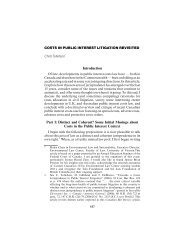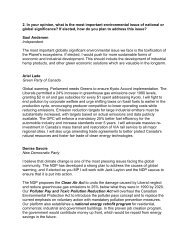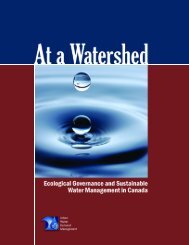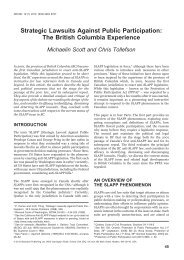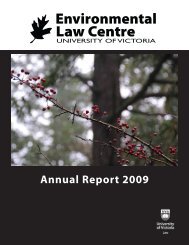Peeling back the Pavement - POLIS Water Sustainability Project
Peeling back the Pavement - POLIS Water Sustainability Project
Peeling back the Pavement - POLIS Water Sustainability Project
You also want an ePaper? Increase the reach of your titles
YUMPU automatically turns print PDFs into web optimized ePapers that Google loves.
Blueprint principle 3: new governance<br />
an integrated watershed-based approach<br />
first Step<br />
Integrate <strong>Water</strong> Service Departments<br />
Merge water departments so that drinking water supply, stormwater,<br />
and wastewater are managed as a single system that<br />
mimics <strong>the</strong> natural water cycle.<br />
Establish a Regional <strong>Water</strong> Commission, Agency, or Authority<br />
Establish a regional watershed entity with a clear mandate<br />
to address watershed-level issues and decision-making powers<br />
as <strong>the</strong>y relate to land-use decisions that impact water<br />
resources. This body should have broad responsibilities and<br />
be tasked with catalyzing action to deal with water in a comprehensive,<br />
integrated way using best practices in planning<br />
and bylaw approaches. A Regional <strong>Water</strong> Commission could<br />
ensure consistent action for different types of landscapes<br />
across urban regions or act as a support for municipalities<br />
that do not have <strong>the</strong> in-house expertise to address <strong>the</strong> challenges<br />
of integrated rainwater management. An important<br />
starting point for this kind of body is to coordinate <strong>the</strong> development<br />
of an integrated water management plan for <strong>the</strong><br />
region. It could also provide expertise and support to municipalities<br />
implementing <strong>the</strong> plan by helping to draft—and<br />
enforce—<strong>the</strong> bylaws, policies, and technical standards necessary<br />
to achieve <strong>the</strong> targets set out by <strong>the</strong> plan. In some<br />
jurisdictions, regional governments, such as Conservation<br />
Authorities or Regional Districts, already fulfill some of <strong>the</strong>se<br />
roles. The goal of a Regional <strong>Water</strong> Commission would be<br />
to formalize coordination between all relevant jurisdictions<br />
and municipalities. To start, such an entity could be funded<br />
through rainwater utility charges.<br />
next steps<br />
Create an Integrated <strong>Water</strong> Management Plan<br />
Base <strong>the</strong> rainwater sections of <strong>the</strong> plan on runoff volume<br />
reduction, water quality, and rate control/detention. Ensure<br />
implementation by incorporating <strong>the</strong> plan into land-use and<br />
community and regional planning documents.<br />
Legislate Integrated <strong>Water</strong> Management Plans<br />
Amend <strong>the</strong> relevant sections of provincial and territorial Environmental<br />
Management Acts to mandate <strong>the</strong> development of<br />
watershed-based water management plans. Explicitly define<br />
<strong>the</strong> key content required in such a plan. Link <strong>the</strong> development<br />
and execution of <strong>the</strong> integrated water management plan to<br />
eligibility for infrastructure funding or programs.<br />
50



